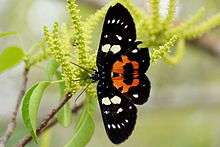Episteme adulatrix
Episteme adulatrix, the day flying moth,[2] is a species of moth in the genus Episteme of the family Noctuidae.[3][4]
| Episteme adulatrix | |
|---|---|
 | |
| Scientific classification | |
| Kingdom: | |
| Phylum: | |
| Class: | |
| Order: | |
| Family: | |
| Genus: | |
| Species: | E. adulatrix |
| Binomial name | |
| Episteme adulatrix (Kollar, 1844)[1] | |
| Synonyms | |
|
List
| |
Description
Episteme adulatrix has a wingspan of about 66 millimetres (2.6 in).[6] The upperside of the forewings is black, with large yellow markings, a row of small white spots and pale blue spots at the base. The upperside of the hindwings is black, with small white submarginal spots and orange spots near the anal angle. Head, thorax and abdomen are black, abdomen with blood-red bands.[7][6]
Biology
It is a day flying moth (hence the common name). Caterpillars feed on Solanum tuberosum.[8]
Gallery
_1.jpg) Upperside
Upperside.jpg)
- Museum specimen
gollark: No, C the programming language.
gollark: See, sponge has weak stats, *but* gives you silk touch without taking a modifier slot.
gollark: That's why C is so awful to use lots of the time.
gollark: Good tools are important!
gollark: Er, knightslime HEAD embossment.
References
| Wikimedia Commons has media related to Episteme adulatrix. |
| Wikispecies has information related to Episteme adulatrix |
- Episteme adulatrix on eol.org
- Report of the “Study of the Biodiversity of Indian Institute of Technology Bombay Campus” by World Wide Fund for Nature -India, Maharashtra State Office, Mumbai
- Catalogue of life
- Beccaloni, G.; Scoble, M.; Kitching, I.; Simonsen, T.; Robinson, G.; Pitkin, B.; Hine, A.; Lyal, C., eds. (2003). "Episteme adulatrix". The Global Lepidoptera Names Index. Natural History Museum. Retrieved May 17, 2018.
- Savela, Markku. "Episteme adulatrix (Kollar, [1844])". Lepidoptera and Some Other Life Forms. Retrieved May 17, 2018.
- India Biodiversity
- Westwood, J. O. The cabinet of oriental entomology : being a selection of some of the rarer and more beautiful species of insects, natives of India and the adjacent islands, the greater portion of which are now for the first time described and figured
- HOSTS - a Database of the World's Lepidopteran Hostplants
External links
This article is issued from Wikipedia. The text is licensed under Creative Commons - Attribution - Sharealike. Additional terms may apply for the media files.